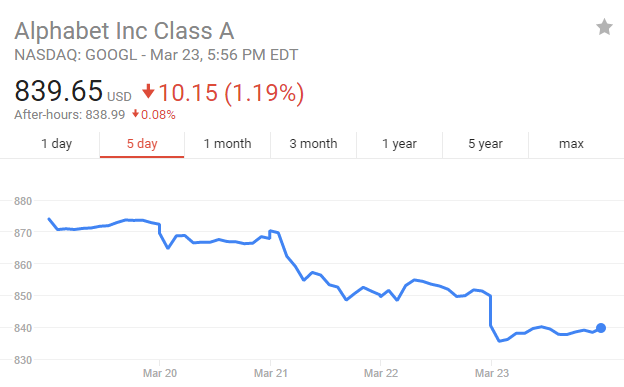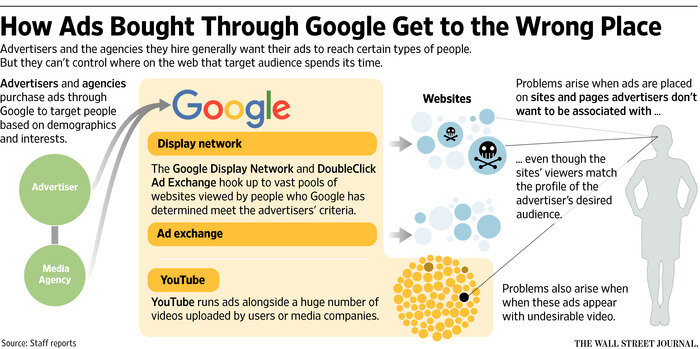The Gloves Are Off: Advertisers Swing Back Against Google
Whether you’re interested in digital advertising or not, chances are you’ve heard about the recent Google // YouTube boycott. A great article by Lara O'Reilly at Business Insider deeply explores the recent fiasco, which all stems from an investigation that found ads appearing alongside extremist content on YouTube.The result? More than 250 brands have banded together and pulled their ad spend from the digital giant. Oh, and did I mention that stock prices have plummeted? Thanks for the image, Google! How TF Did This Happen?When you break it down, it’s pretty simple. Digital advertising purchases are based off of audiences, so instead of buying a singular piece of inventory, advertisers programmatically purchase large amounts of inventory across a variety of websites. But, this results in essentially blanketing ads across the web, with very little control on SPECIFIC placement.And when you pair that with what Google's European boss Matt Brittin explained to Business Insider on Monday, it’s surprising this wasn’t surfaced earlier.“400 hours of user-generated video are uploaded to YouTube every minute and thousands of websites added to Google's AdSense network each day, which makes it extremely difficult to police which content is safe for brands to advertise against and which isn't.”The Wall Street Journal has a great graphic showing this:
How TF Did This Happen?When you break it down, it’s pretty simple. Digital advertising purchases are based off of audiences, so instead of buying a singular piece of inventory, advertisers programmatically purchase large amounts of inventory across a variety of websites. But, this results in essentially blanketing ads across the web, with very little control on SPECIFIC placement.And when you pair that with what Google's European boss Matt Brittin explained to Business Insider on Monday, it’s surprising this wasn’t surfaced earlier.“400 hours of user-generated video are uploaded to YouTube every minute and thousands of websites added to Google's AdSense network each day, which makes it extremely difficult to police which content is safe for brands to advertise against and which isn't.”The Wall Street Journal has a great graphic showing this: The Domino EffectAfter this came to light, advertisers obviously jumped at the chance to take a swing at the ad behemoth. And why not? Google is one part of the duopoly that is dominating the industry, and advertisers are hoping to use this as a bargaining chip in future negotiations.Of the more than 250 advertisers who have pulled advertising spend, some of the more notable include AT&T, Verizon, Audi, Heinz, Honda, L'Oreal, and McDonald's.Google’s Response?The company released a public statement saying, "we can do a better job" and that it would update its ad policies and tools to give brands more control over where their ads appear. Google also announced that they would bring on more employees dedicated to help with the review process.And to close out the blog post, "Finally, we won't stop at taking down ads. The YouTube team is taking a hard look at our existing community guidelines to determine what content is allowed on the platform—not just what content can be monetized."How Can We Prevent This?It comes down to two things, transparency and control. The industry needs tools that will help meticulously place advertisements on digital properties. This is possible with things like review processes, which allow publishers to view individual advertisements that are eligible to run on their property. Publishers can then choose to allow or veto a creative based on a variety of filtering metrics.Whitelists and blacklists can also help with the control process, which define certain websites or content that ads can and cannot appear on.What Does This Mean For The Future?Let’s be real, the chances of this being a permanent boycott is slim to none. The audience that Google can reach is HUGE, and too valuable to advertisers. Brands are just enjoying their time in the sun, and basking in the glory of having the upper hand on Google, for once.Google has shown remorse, and even went into detail about how they are going to combat this. But only time will tell if these changes actually eliminate the problem.This article originally appeared on LinkedIn.Frank Sinton is the Founder and CEO Beachfront Media
The Domino EffectAfter this came to light, advertisers obviously jumped at the chance to take a swing at the ad behemoth. And why not? Google is one part of the duopoly that is dominating the industry, and advertisers are hoping to use this as a bargaining chip in future negotiations.Of the more than 250 advertisers who have pulled advertising spend, some of the more notable include AT&T, Verizon, Audi, Heinz, Honda, L'Oreal, and McDonald's.Google’s Response?The company released a public statement saying, "we can do a better job" and that it would update its ad policies and tools to give brands more control over where their ads appear. Google also announced that they would bring on more employees dedicated to help with the review process.And to close out the blog post, "Finally, we won't stop at taking down ads. The YouTube team is taking a hard look at our existing community guidelines to determine what content is allowed on the platform—not just what content can be monetized."How Can We Prevent This?It comes down to two things, transparency and control. The industry needs tools that will help meticulously place advertisements on digital properties. This is possible with things like review processes, which allow publishers to view individual advertisements that are eligible to run on their property. Publishers can then choose to allow or veto a creative based on a variety of filtering metrics.Whitelists and blacklists can also help with the control process, which define certain websites or content that ads can and cannot appear on.What Does This Mean For The Future?Let’s be real, the chances of this being a permanent boycott is slim to none. The audience that Google can reach is HUGE, and too valuable to advertisers. Brands are just enjoying their time in the sun, and basking in the glory of having the upper hand on Google, for once.Google has shown remorse, and even went into detail about how they are going to combat this. But only time will tell if these changes actually eliminate the problem.This article originally appeared on LinkedIn.Frank Sinton is the Founder and CEO Beachfront Media

